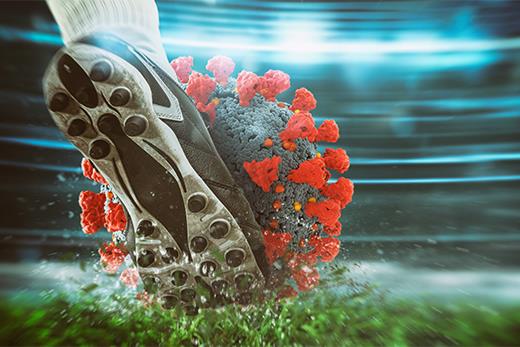Returning to sports after a COVID infection isn’t as straightforward as bouncing back from a common cold. The virus affects individuals differently, and its impact can linger, especially when it comes to physical exertion. Athletes and active individuals must approach their recovery with caution to avoid complications.
Understanding when it’s safe to resume sports is crucial for protecting long-term health. Factors like symptom severity, recovery time, and medical clearance play a significant role. By following expert guidelines, individuals can ensure a safe and effective return to their favorite activities.
How COVID-19 Affects Heart and Lung Function in Athletes
COVID-19 can cause inflammation of the heart muscle, known as myocarditis, which poses risks for athletes engaging in high-intensity activities. This condition may lead to irregular heart rhythms or, in severe cases, sudden cardiac events during exertion. Studies indicate myocarditis occurs in approximately 1-5% of individuals with COVID-19, though the rate may be higher in symptomatic or hospitalized cases.
The lungs often experience reduced capacity due to inflammation or scarring following COVID-19, which impacts oxygen delivery during physical activity. Many athletes report lingering symptoms like shortness of breath, reduced stamina, and chest discomfort even weeks after illness resolution. These effects can restrict performance and prolong recovery times.
Monitoring heart and lung function is essential when Returning to Sports After COVID-19. Medical evaluations, including echocardiograms, exercise stress tests, or pulmonary function tests, help identify residual issues. Resources such as cardiocarellc.com underscore the importance of assessing post-COVID health before resuming athletic activities safely.
The Importance of Medical Screening Before Returning to Sports
Medical screening helps identify residual effects of COVID-19 that could pose risks during athletic activities. Post-COVID conditions such as myocarditis, reduced lung capacity, or lingering fatigue can compromise performance and safety if left undiagnosed. Comprehensive evaluations ensure that athletes can return to sports safely.
Doctors often recommend tests targeting the heart and lungs. Electrocardiograms (ECGs) assess heart rhythm abnormalities, while echocardiograms check for myocarditis or structural damage. Pulmonary function tests measure lung capacity and respiratory efficiency. For individuals with severe symptoms or hospitalizations, stress tests and cardiac MRIs may also be necessary. These screenings provide critical insights into the body’s readiness for physical exertion.
Guidelines from cardiology and sports medicine authorities prioritize screening for athletes of all levels. Children, recreational athletes, and professionals may require clearances based on symptom history and recovery progress. Resources such as cardiocarellc.com offer information on managing heart health during recovery and preparing for safe participation in physical activities after COVID.
Ignoring medical evaluations increases the risk of severe complications. Undetected myocarditis may lead to life-threatening events when resuming high-intensity exercises. Reduced lung capacity can limit stamina or prolong recovery times, affecting sports performance. Medical screenings minimize these risks, enabling athletes to resume activities with confidence and reduced health concerns.
Warning Signs That Indicate an Athlete Isn’t Ready for Intense Activity
Persistent Symptoms Post-Recovery
Athletes experiencing ongoing symptoms, such as chest pain, shortness of breath during light exertion, extreme fatigue, or palpitations, may not be ready for high-intensity activity. These symptoms suggest that the body hasn’t fully recovered from the infection.
Irregular Heart Function
Abnormalities like irregular heart rhythms or elevated resting heart rates indicate potential heart strain. Medical tests, such as ECGs or cardiac evaluations, can identify issues like myocarditis, which increases risks during physical exertion.
Reduced Lung Capacity
Breathing issues, such as a noticeable reduction in stamina or inability to perform moderate exercises without discomfort, signal incomplete respiratory recovery. Residual lung inflammation or scarring could impair oxygen flow, putting athletes at a higher risk.
Inability to Complete Gradual Fitness Programs
Failing to progress through gradual return-to-play protocols without setbacks points to underlying health concerns. Symptoms worsening with increased activity levels suggest the athlete’s system isn’t prepared for intense demands.
Mental or Physical Fatigue
Ongoing physical exhaustion or mental fog, even at rest, limits focus and performance. This could stem from post-viral fatigue, which recovery protocols must address before returning to sports.
Athletes showing these warning signs need targeted evaluations. Comprehensive guidance, as highlighted on platforms like cardiocarellc.com, supports safer athletic recovery and improved health outcomes.
Expert Guidelines on Phased Return to Training and Competition
Phased return-to-play protocols ensure recovery aligns with an athlete’s physical and cardiovascular readiness post-COVID. These guidelines incorporate individual symptoms, recovery progress, and medical evaluations to provide a structured path back to activity.
Initial Rest Period
Athletes should refrain from all sports during the first 7-14 days after symptom onset or a positive test, focusing on rest and recovery. Those with fevers, persistent fatigue, or breathing difficulties require additional rest days.
Light Activity Stage
Light activities like walking or stretching can begin after 2-3 symptom-free days, provided there’s no chest discomfort or abnormal fatigue. This stage avoids exertion that could strain the cardiovascular system.
Controlled Cardiovascular Training
If light activity is tolerable, low-intensity cardio such as cycling or jogging is recommended, starting with 10-15 minutes and increasing gradually over a week. Heart rate monitoring for irregularities is advised.
Progressive Strength Training
Strength exercises can be reintroduced if no symptoms or irregular heart rhythms are present during initial cardio sessions. Efforts should remain at 50-70% of pre-illness intensity levels.
Full Training and Competition Readiness
Athletes resume regular training only after receiving medical clearance, particularly for those with moderate to severe illness. A minimum of two weeks without lingering symptoms is critical before engaging in high-impact sports.
These phases emphasize safety by addressing risks such as myocarditis and reduced lung capacity. Consistent monitoring, including the use of resources like cardiocarellc.com, supports informed decisions during athletic recovery.
The Role of Cardiac MRI and Other Tests in Assessing Post-COVID Risk
Cardiac MRI plays a key role in identifying heart-related complications in athletes recovering from COVID-19. This imaging method detects myocarditis by evaluating heart muscle inflammation, scarring, or diminished function, even in asymptomatic individuals or those with mild cases. Its sensitivity makes it essential for athletes with moderate to severe illness or persistent symptoms such as chest pain or irregular heart rhythms.
Other diagnostic tests complement cardiac MRI in assessing post-COVID cardiac and pulmonary risks. Electrocardiograms (ECGs) identify abnormal heart rhythms, while echocardiograms assess structural heart function. Stress tests measure cardiovascular response during physical activity. Pulmonary function tests evaluate lung capacity to detect lasting respiratory issues impacting performance and endurance.
For athletes returning to sports after COVID infections, following these evaluations ensures readiness for physical exertion and minimizes health risks. Cardiac MRI, combined with broader diagnostic testing, provides medical clarity for safe athletic recovery while addressing concerns outlined by expert sports medicine authorities and resources like cardiocarellc.com.
How Athletes Can Safeguard Their Heart Health After Recovery
Returning to sports after a COVID infection requires careful planning and medical oversight to ensure safety. Athletes should prioritize comprehensive health evaluations to detect lingering effects on the heart and lungs. Following expert-recommended return-to-play protocols and addressing symptoms like fatigue, chest pain, or breathing issues are critical steps toward a safe recovery.
By staying informed and adhering to phased recovery plans, athletes can reduce risks and regain their performance levels gradually. Consulting with healthcare professionals and utilizing resources like cardiocarellc.com provides valuable support for navigating the recovery process with confidence.




